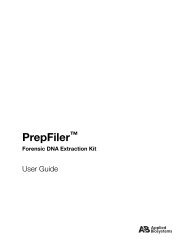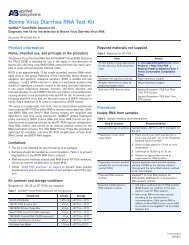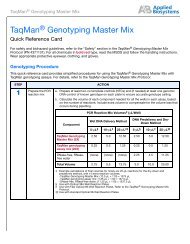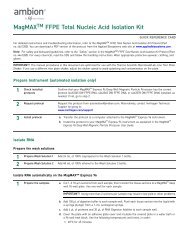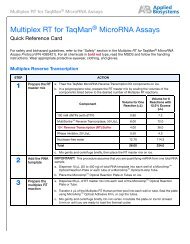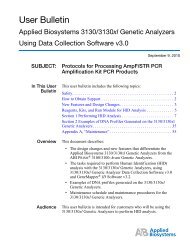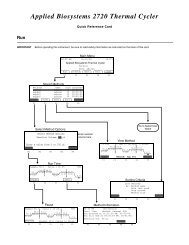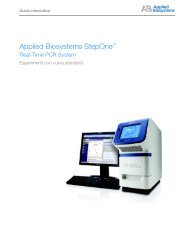AmpliTaq and AmpliTaq Gold DNA Polymerase - Applied Biosystems
AmpliTaq and AmpliTaq Gold DNA Polymerase - Applied Biosystems
AmpliTaq and AmpliTaq Gold DNA Polymerase - Applied Biosystems
Create successful ePaper yourself
Turn your PDF publications into a flip-book with our unique Google optimized e-Paper software.
Post, D. M. B., N. J. Phillips, et al. (2002). "Intracellular Survival of Neisseria gonorrhoeae in MaleUrethral Epithelial Cells: Importance of a Hexaacyl Lipid A." Infect. Immun. 70(2): 909-920.http://iai.asm.org/cgi/content/abstract/70/2/909Neisseria gonorrhoeae is a strict human pathogen that invades <strong>and</strong> colonizes the urogenitaltracts of males <strong>and</strong> females. Lipooligosaccharide (LOS) has been shown to play a role ingonococcal pathogenesis. The acyl transferase MsbB is involved in the biosynthesis of the lipid Aportion of the LOS. In order to determine the role of an intact lipid A structure on the pathogenesisof N. gonorrhoeae, the msbB gene was cloned <strong>and</strong> sequenced, a deletion <strong>and</strong> insertion mutationwas introduced into N. gonorrhoeae, <strong>and</strong> the mutant strain was designated 1291A11K3. Massspectrometric analyses of 1291A11K3 LOS determined that this mutation resulted in a pentaacylrather than a hexaacyl lipid A structure. These analyses also demonstrated an increase in thephosphorylation of lipid A <strong>and</strong> an increase in length of the oligosaccharide of a minor species ofthe msbB LOS. The interactions of this mutant with male urethral epithelial cells (uec) wereexamined. Transmission <strong>and</strong> scanning electron microscopy studies indicated that the msbBmutants formed close associations with <strong>and</strong> were internalized by the uec at levels similar to thoseof the parent strain. Gentamicin survival assays performed with 1291A11K3 <strong>and</strong> 1291 bacteriademonstrated that there was no difference in the abilities of the two strains to adhere to uec;however, significantly fewer 1291A11K3 bacteria than parent strain bacteria were recovered fromgentamicin-treated uec. These studies suggest that the lipid A modification in the N. gonorrhoeaemsbB mutant may render it more susceptible to innate intracellular killing mechanisms wheninternalized by uec.Shea, R. J. <strong>and</strong> M. H. Mulks (2002). "ohr, Encoding an Organic Hydroperoxide Reductase, Is an In Vivo-Induced Gene in Actinobacillus pleuropneumoniae." Infect. Immun. 70(2): 794-802.http://iai.asm.org/cgi/content/abstract/70/2/794Actinobacillus pleuropneumoniae is the causative agent of porcine pleuropneumonia, a diseasecharacterized by pulmonary necrosis <strong>and</strong> hemorrhage caused in part by neutrophil degranulation.In an effort to underst<strong>and</strong> the pathogenesis of this disease, we have developed an in vivoexpression technology (IVET) system to identify genes that are specifically up-regulated duringinfection. One of the genes that we have identified as being induced in vivo is ohr, encodingorganic hydroperoxide reductase, an enzyme that could play a role in detoxification of organichydroperoxides generated during infection. Among the 12 serotypes of A. pleuropneumoniae, ohrwas found in only serotypes 1, 9, <strong>and</strong> 11. This distribution correlated with increased resistance tocumene hydroperoxide, an organic hydroperoxide, but not to hydrogen peroxide or to paraquat, asuperoxide generator. Functional assays of Ohr activity demonstrated that A. pleuropneumoniaeserotype 1 cultures, but not serotype 5 cultures, were able to degrade cumene hydroperoxide. InA. pleuropneumoniae serotype 1, expression of ohr was induced by cumene hydroperoxide, butnot by either hydrogen peroxide or paraquat. In contrast, an ohr gene from serotype 1 cloned intoA. pleuropneumoniae serotype 5 was not induced by cumene hydroperoxide or by other forms ofoxidative stress, suggesting the presence of a serotype-specific positive regulator of ohr in A.pleuropneumoniae serotype 1.Gat, O., I. Inbar, et al. (2003). "Use of a Promoter Trap System in Bacillus anthracis <strong>and</strong> Bacillus subtilisfor the Development of Recombinant Protective Antigen-Based Vaccines." Infect. Immun. 71(2):801-813.



